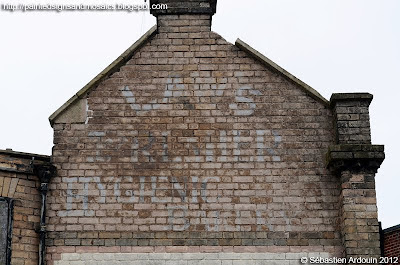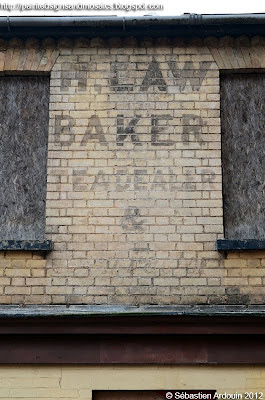However these three ghost signs overlap and if two are easy to identify, the third one is trickier - but not impossible after a closer look.
Could anything else have been written with 'Royan'? I think so but I am not sure. Maybe the name of the popular seaside town by the mouth of the Gironde estuary about 100 km from Saint-André-de-Cubzac was enough to attract visitors?
Below, in blue, is the name of France's leading beer brand: Kronenbourg (commonly known as 'Kro') with the slogan "Le grand nom des bières d'Alsace" ("The famous name among Alsace beers"). The brewery was founded in 1664 by Geronimus Hatt in Strasbourg. Being close to the River Ill, it was flooded on several occasions. In 1850 Frédéric-Guillaume Hatt relocated it to higher grounds in Cronenbourg, just to the northwest of Strasbourg city centre. The site also had the advantage of being near railway tracks and from 1857, weekly first and then daily beer trains ran between the brewery and Paris. The beer known today as Kronenbourg was first brewed in 1922. That year the Hatt family bought the famous restaurant Grand Tigre and launched a new beer, Tigre Bock, to celebrate this acquisition. In 1947 Jérôme Hatt changed its name to Kronenbourg. Sold in returnable 33cl bottles, it was an immediate success not only in France but in other European countries as well. In 1970 the family brewery was bought by BSN (nowadays Groupe Danone). Sixteen years later BSN merged its two brewing concerns, Kronenbourg and Européenne de Brasseries (Kanterbräu), to create Brasseries Kronenbourg.
In 2000 BSN sold the company to Scottish and Newcastle at a difficult time. By the turn of the 21st century sales of Kronenbourg were dropping sharply indeed. If 10 m hl were brewed in 1999, by 2007 the figure was down to 7 m hl. In that context the new owners decided to concentrate the production at the Obernai brewery opened in 1969 and disposed of other production sites. In 2006 all activity ceased at the Cronenbourg site and within a few months most of the buildings were demolished. In 2008 Scottish and Newcastle sold Kronenbourg to Danish brewers Carlsberg.
The most visible part of the third ghost sign is the word 'pellicule' (film) in a rectangular frame. A closer look shows 'Royan' hides the name of the company advertised there: Altipan Lumière. Founded by cinema pioneers Auguste and Louis Lumière, it manufactured photography equipment. In the 1960s it was taken over by Ilford Photo.
Location: Rue Nationale, Saint-André-de-Cubzac, Gironde / Pictures taken in May 2012























































%20Costaros%20N88.JPG)







